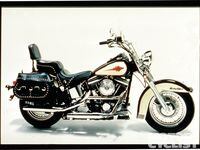- Got a question for Answers? Send it to mcmail@sorc.com
Q: I have replaced the starter drive on my 1997 Harley-Davidson Softail Classic three times. Every two or three years, this problem inevitably re-occurs. First it starts with the starter hesitating; then a grinding noise. Sometimes the grinding lasts a short while, sometimes it goes on for a little longer, and then it finally starts. After a few months of this routine, the starter fails to engage altogether and leaves me stranded somewhere. What is the source of this problem, and is there a permanent fix? My mechanic seems very capable, but the only thing he can do is replace the starter drive at a cost of $600-$700.
Joe Pedulla
Andover, MA
A: The starter drive on Big Twins of this era has a reputation for relatively short life, but there doesn't seem to be a consensus on the cause. The H-D starter is shared with a variety of cars, so it should be fine for a stock motorcycle engine. If you have a big-inch or high-compression motor without compression releases, you can expect very short starter clutch life. The All Balls starter clutch has a good reputation for longevity and price. Some owners claim that a starter motor with a higher torque output is a good idea as well. We spoke with Micah McCloskey at Micah McCloskey's Custom Cycles (www.micahscustomcycles.com), who doesn't think the stock starter clutch is as suspect as many suggest. He did, however, feel that the price you paid for repairs was in the ballpark.
McCloskey emphasized inspecting the entire starting system: the grounds, cables, relays and other parts. Make sure you have a quality battery that has plenty of cranking power. The H-D starter engages a gear on the starter clutch that is mounted on a jackshaft. The end of the jackshaft is supported by a bushing in the primary cover. McCloskey suggests removing the primary cover (drain the fluid first), taking the sparkplug caps off (so the engine doesn’t start), then hitting the starter repeatedly. If the engine spins every time, there may be a misalignment with the bushing in the primary cover. Also check the teeth on the starter, all the gears on the shaft and the ring gear on the clutch. If all the parts are in good shape, there is no play in the jackshaft and all the electrons are getting where they need to go, then you have done all you can. We’d suggest changing the starter clutch at the first hint of trouble. Then the bike won’t leave you stranded.
Nice piece by Tim Carrithers about the 1969-’78 Honda CB750 (Smart Money, MC, May 2012). In addition to oil weeping from the head gasket, there is a common, easily fixed leak from the tachometer drive on the top right side of the motor. The oil seal there can be replaced without removing anything more than the tach cable. A small, hooked probe will get it out and the new one can be tapped in with the right-size deep socket, a piece of tubing or a seal driver.
More serious are the aged rubber parts of the cam-chain tensioner. These become brittle and frequently lose chunks of rubber, polluting the engine oil and reducing tension on the cam chain. Excess slack can be heard as a rattling, slapping noise, and should be remedied immediately. The tensioner is a critical part, and replacing it requires engine removal and disassembly of the entire top end. Risking a tensioner or cam-chain failure is not a good bet. Unfortunately, rubber parts don’t age well.
Neil Tolhurst
New Hartford, CT












/cloudfront-us-east-1.images.arcpublishing.com/octane/FZXHNOQRNVA3BIDWAF46TSX6I4.jpg)
/cloudfront-us-east-1.images.arcpublishing.com/octane/JRSFLB2645FVNOQAZCKC5LNJY4.jpg)
/cloudfront-us-east-1.images.arcpublishing.com/octane/ITNLTIU5QZARHO733XP4EBTNVE.jpg)
/cloudfront-us-east-1.images.arcpublishing.com/octane/VZZXJQ6U3FESFPZCBVXKFSUG4A.jpg)
/cloudfront-us-east-1.images.arcpublishing.com/octane/QCZEPHQAMRHZPLHTDJBIJVWL3M.jpg)
/cloudfront-us-east-1.images.arcpublishing.com/octane/HXOUJXQWA5HBHGRO3EMJIGFMVI.jpg)

/cloudfront-us-east-1.images.arcpublishing.com/octane/3TIWWRV4JBBOLDVGRYECVVTA7Y.jpg)
/cloudfront-us-east-1.images.arcpublishing.com/octane/KIX5O23D5NAIBGFXBN3327DKZU.jpg)
/cloudfront-us-east-1.images.arcpublishing.com/octane/7GJYDUIPXRGMTMQKN6ONYOLBOU.jpg)
/cloudfront-us-east-1.images.arcpublishing.com/octane/MUQLOVLL2ZDGFH25ILABNBXKTI.jpg)
/cloudfront-us-east-1.images.arcpublishing.com/octane/TNOU5DNE2BC57MFPMGN2EIDXAM.jpg)
/cloudfront-us-east-1.images.arcpublishing.com/octane/GTCXACQGJ5HAPDTGWUQKDEH44E.jpg)
/cloudfront-us-east-1.images.arcpublishing.com/octane/S35YGSEMEZB4BLTDJTSZPF4GLA.jpg)
/cloudfront-us-east-1.images.arcpublishing.com/octane/5UOT6HPX2JFMRJAX6EH45AR4MQ.jpg)
/cloudfront-us-east-1.images.arcpublishing.com/octane/OKWOJWAKP5EP3OACCRRWPCIX2Q.jpg)
/cloudfront-us-east-1.images.arcpublishing.com/octane/2WF3SCE3NFBQXLDNJM7KMXA45E.jpg)
/cloudfront-us-east-1.images.arcpublishing.com/octane/G4MG6OUCJNBSHIS2MVVOTPX65E.jpg)
/cloudfront-us-east-1.images.arcpublishing.com/octane/IIGGWFOTOJGB7DB6DGBXCCMTDY.jpg)
/cloudfront-us-east-1.images.arcpublishing.com/octane/QSTCM6AVEZA5JJBUXNIQ3DSOF4.jpg)
/cloudfront-us-east-1.images.arcpublishing.com/octane/U4I7G625B5DMLF2DVIJDFZVV6M.jpg)
/cloudfront-us-east-1.images.arcpublishing.com/octane/B6XD6LS6IVCQPIU6HXDJSM3FHY.jpg)
/cloudfront-us-east-1.images.arcpublishing.com/octane/ICL63FEDDRDTTMINYICCEYGMDA.jpg)
/cloudfront-us-east-1.images.arcpublishing.com/octane/FCGZHQXRBZFLBAPC5SDIQLVF4I.jpg)